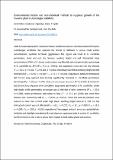| dc.description.abstract | Little is known about preferred environmental conditions and non-chemical control of invasive Gutenbergia cordifolia. We assessed the effects of different A. annua crude extract concentrations, synthetic herbicide (glyphosate), fire regime and shade to G. cordifolia germination, shoot and root dry biomass, seedling height and leaf chlorophyll. High concentrations (75%) of A. annua crude extracts significantly reduced germination percentage of G. cordifolia by 25% (F2,4=77.2, p < 0.001), and suppressed shoot and root dry biomass (F2,4 = 80.3, p < 0.001; F2,4=46.104, p < 0.001, respectively) as well as seedling height and leaf chlorophyll (F2,4 = 12.02, p < 0.002; F2,4 = 15.9, p < 0.001), respectively. Medium temperature (60 °C) and long exposure time (5 min) significantly increased G. cordifolia germination percentage (F2,7 = 32.6, p < 0.001) while extreme temperatures (≥150 °C) at both (1 min) short and (5 min) long exposure time completely suppressed germination of G. cordifolia. Under high shade, while germination percentage was a third that of other treatments (F 2, 4 = 20.9, p = 0.008), mean germination took twice as long (F2, 4 = 17.9, p = 0.010) and shoot fresh biomass was reduced by half (F 2, 4 = 16.92, p = 0.004). Shoot and root dry biomass were reduced to more than a third under high shade, seedling height reduced to half but leaf chlorophyll content was not affected (F 2,4 = 6.3, p = 0.030; F 2,4 = 9.1, p = 0.020; F 2,4 = 18.3, p = 0.003; F 2,4 = 3.02, p = 0.120, respectively). We suggest using A. annua as a potential bio-herbicide and highlight considering fire and shade as suppressor tools to control G. cordifolia, but first include in-situ trials to assess their impacts to both native plants and animals. | en_US |

